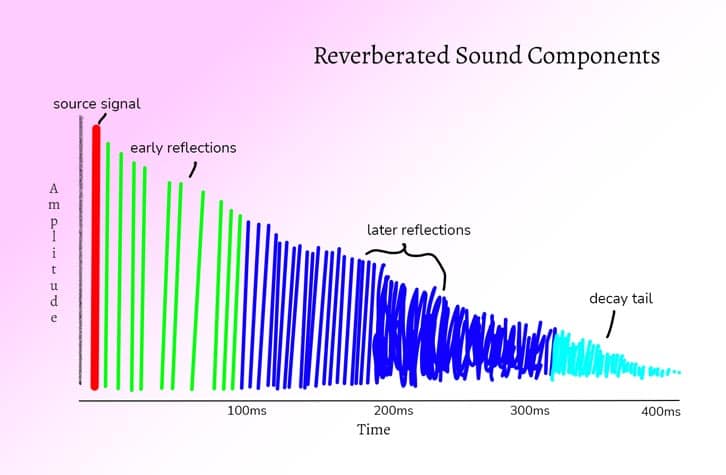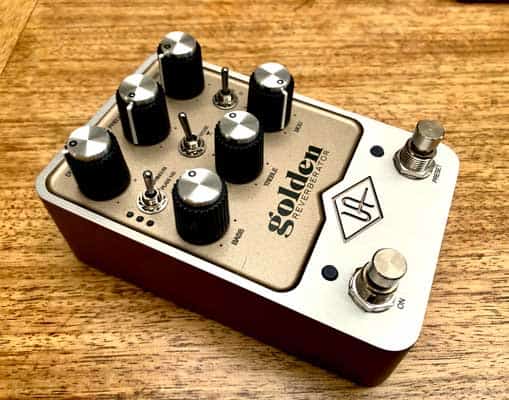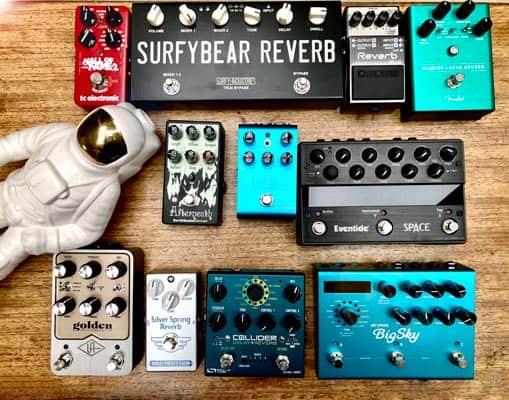What is Reverb?
Reverb, known as reverberation in full, plays a crucial role in music production. It’s the process where sound waves bounce off various surfaces, merging into a series of overlapping echoes. This phenomenon creates an illusion of spatial depth and dimension in music.
There are many types of reverb. Engineers and musicians have used a diverse range of techniques and technologies over the years, resulting in a wide range of reverb sounds available.
In this article, we’re discussing reverb specifically as it relates to guitars and guitar pedals. See here for reviews and info about guitar equipment and here for our complete guide to reverb pedals.
The Anatomy of Reverb
The source of a sound emanates sound waves and these waves eventually hit surfaces in an acoustic space. When they do they reflect sound back which mixes in with the original sound.

What we end up hearing can be broken down into the following parameters:
Pre-delay
This is the amount of time between the initial sound and the first reflections
Early Reflections
The first echoes that occur when the source sound hits a surface. Pre-delay and Early Reflections give us an idea of where we are in a space, how large the space is.
Later Reflections
The later reflections are a mix of reflections and the source signal. As reflections create more reflections, they happen with greater frequency.
Decay
Decay is the amount of time it takes for a sound to die away. This parameter also gives us an idea of the size of a space.
Types of Reverb
Mechanical Reverb
The first reverb tech used mechanical means to create a reverb effect, the most common of which are Spring and Plate Reverb.
Spring Reverb
First used on Hammond Organs, spring reverb became most popular for use with guitars in amps and pedals.
Favored in classic guitar amplifiers, spring reverb utilizes a series of springs to generate its effect. As the guitar’s audio signal passes through these springs, they resonate, creating a distinct reverberation known for its slightly metallic timbre. This reverb type is a hallmark of genres like rock and surf music.
Plate Reverb
Common in studio settings, plate reverb uses a large metallic plate to produce its effect. The vibrations from the guitar signal are transmitted to the plate, and these oscillations are then captured, resulting in a rich and enveloping sound. Plate reverb is renowned for its smooth and deep sonic qualities, often employed to enhance studio recordings.

Mechanical plate reverb requires large plates of metal and tends not to be used outside a studio. As a result, digital plate reverbs are much more attractive to most users.
Acoustic Reverbs
Acoustic reverbs are emulations of different spaces. The shape and size of the space as well as the material of the walls all change the characteristics of the acoustic space. Studios used to have their own reverb rooms where the signal was played and recorded in a particular space. These acoustic properties are mimicked in digital emulations today and given the following types:
Room Reverb
Room reverb subtly enhances guitar tones, perfect for crafting an intimate or small-venue feel. They consist of mostly early reflections. It adds just enough ambiance to enrich the sound without overshadowing the original tone.
Hall Reverb
Hall reverb creates a broader, more expansive sound, mimicking the acoustics of large concert halls. It’s ideal for producing grand and voluminous guitar tones, commonly used in classical and orchestral music genres.
Hall reverbs have long decays that can last for several seconds.
Chamber Reverb
Chamber reverb offers an in-between sound between Room and Hall. They tend to keep the excitement of early reflections with the longer tails of late reflections.
It brings depth and warmth to the guitar’s sound, suitable for detailed and expressive musical styles.
Digital Reverbs
Digital reverbs encompass various types, replicated through computer algorithms or samples from actual acoustic settings, which are then modified.
Digital technology in the late 1970s changed audio forever, including our ideas about reverb. Digital reverbs encompass various types, replicated through computer algorithms or samples from actual acoustic settings, which are then modified.
Legendary machines like the EMT 250, Lexicon 224 and 480, and Yamaha Rev7 and SPX90 made it possible to alter parameters that couldn’t be altered in real life to create new reverb effects.
Digital emulations of Mechanical Reverbs and Acoustic Reverbs soon became the norm. These can now be found in reverb pedals, VST plugins, and synthesizer modules with built-in reverb.
Convolution Reverb
This advanced digital technique accurately reproduces the acoustics of real-world spaces. By utilizing impulse responses, it captures the distinct acoustic properties of various environments, from small rooms to large concert halls, delivering highly authentic and immersive reverb sounds.
On the downside, convolution reverb is not all that flexible in its parameters. Decay time and other parameters are pre-baked and not adjustable.
Bloom Reverb
The term ‘bloom’ describes a reverb effect where the initial reflections start quietly and gradually increase in volume and intensity into the decay phase. This produces an unnatural sound, making it a favorite in experimental, industrial, ambient, and electronic music genres.
Gated Reverb
Gated reverbs, similar in tone to room or chamber reverbs, feature an extended decay. The distinctive aspect is their passage through a noise gate, abruptly cutting off the tail. This effect, once laborious to create manually, is now easily achieved with plugins. Gated reverbs gained fame in 1980s pop music, particularly with snare drums, and are experiencing a resurgence in genres like synth-wave.
Shimmer Reverb
Shimmer reverbs are characterized by their brightness, achieved by processing them through one or several pitch shifters. This results in a standard reverb being shifted up an octave, emphasizing higher frequencies. Common in 1990s dance music, shimmer reverbs add sparkle and brilliance, often used with synthesizer pads, ethereal samples, and string pizzicato, although their application is somewhat niche.
Reverse Reverb
Reverse reverb involves inverting a reverb tail so it gradually increases in volume and positioning it before the instrument’s sound. Historically achieved by reversing tape recordings, this effect was primarily used in horror, sci-fi, and fantasy soundtracks. It has since found broader use in dance music and genres like dubstep, often in building up to a climactic drop.
Non-Linear Reverb
Non-linear reverbs deviate from the typical logarithmic decay of standard reverbs. They often resemble gated reverbs but are created differently, using multitap delays and short diffusers. Despite their unique creation process, they tend to have a similar sound and feel reminiscent of the 1980s.
Frequently Asked Questions about Reverb
Where does Reverb belong in a pedalboard signal chain?
Typically, in a standard signal chain, you would find the reverb positioned at the end. In a pedalboard setup, if your guitar amp includes an effects loop, placing the reverb pedal within this loop can enhance the clarity of your sound.
It’s helpful to experiment with the placement of your reverb pedal, as preferences can vary among guitarists. A good starting point is: Compressor – Wah – Drive – Fuzz – Modulation – Delay – Reverb.
Some shoegaze musicians, opt to place it at the start, even before distortion and fuzz pedals, to achieve a dense, enveloping sound.
What is the difference between Reverb and Echo?
Echo and reverberation are similar in that they both involve sound reflections, but they differ in their timing. Echo is the prolonged reflection of sound from a distant hard surface, whereas reverb involves much quicker reflections, bouncing off closer surfaces around the listener.
For instance, when echo is applied to a spoken sentence, the sound will be heard after the sentence is completed. On the other hand, if reverb is applied, the reflected sound is heard almost immediately, often before the first word is fully spoken. This shows that while reverb and echo have their distinctions, they are closely related.
What’s the difference between Delay and Reverb?
Reverb can be considered a form of delay, yet the auditory effects produced by reverb and delay pedals are distinct. Reverb contributes to the sustain and atmosphere of your notes, whereas delay creates echoes of your notes at set intervals.
Is It Necessary to Have Both Delay and Reverb Pedals?
Both reverb and delay pedals offer impressive sounds individually, but their combination can create captivating soundscapes. Integrating a delay pedal with a reverb pedal can produce rich ambient tones, or they can be used together to add dynamic layers to your solos. Having both a delay and a reverb pedal or a combo pedal like the Source Audio Collider provides a lot of creative possibilities.
If you reduce the reflection time of any echo, you will have reverb.
Questions or Comments?
Follow the discussion here on Facebook.
